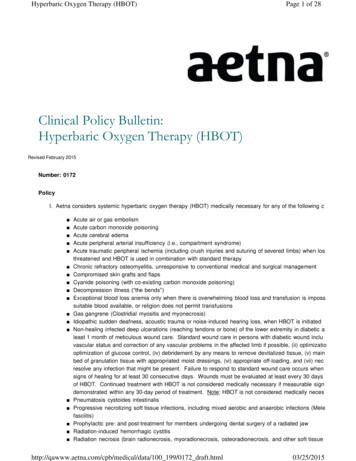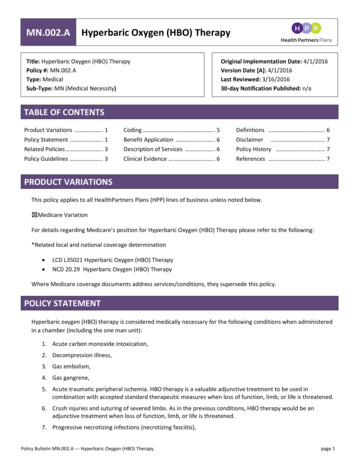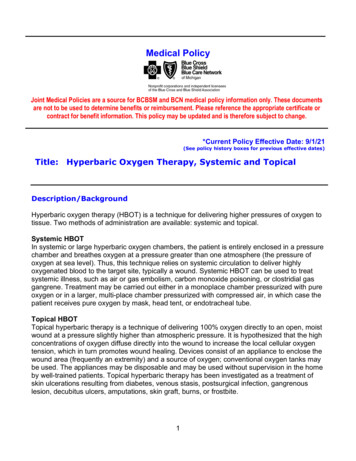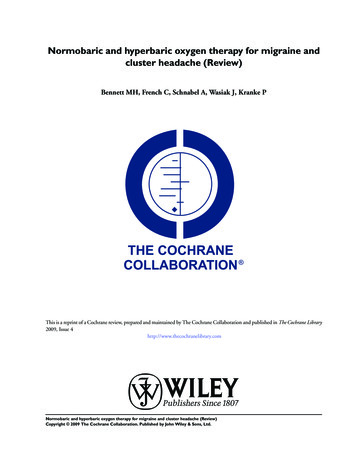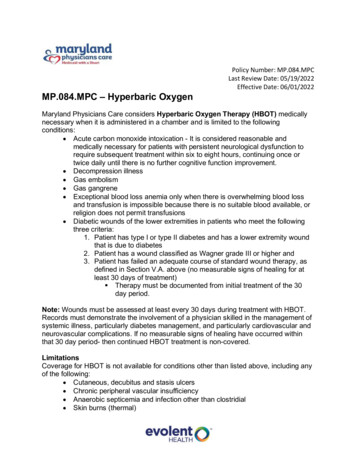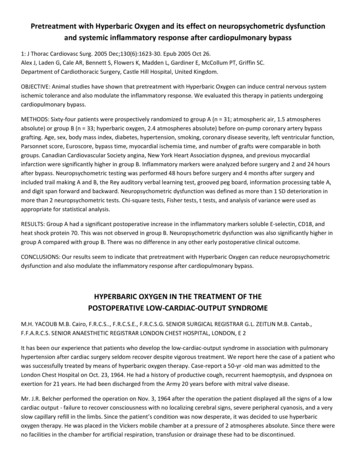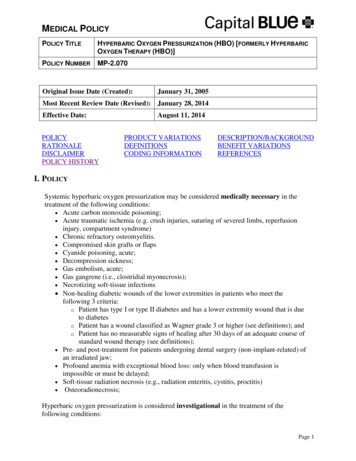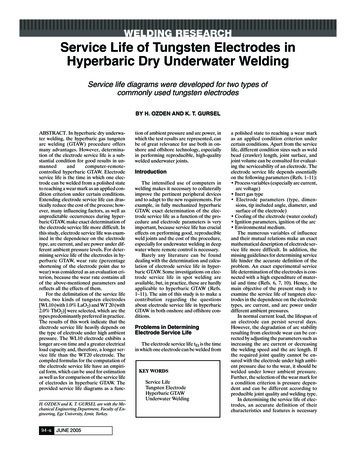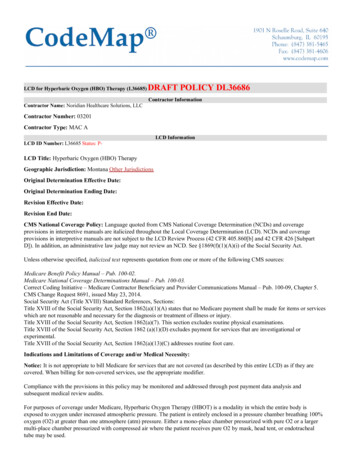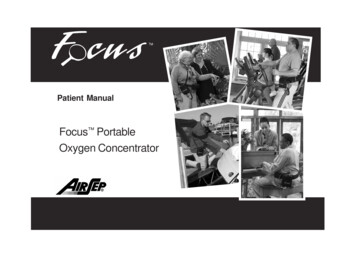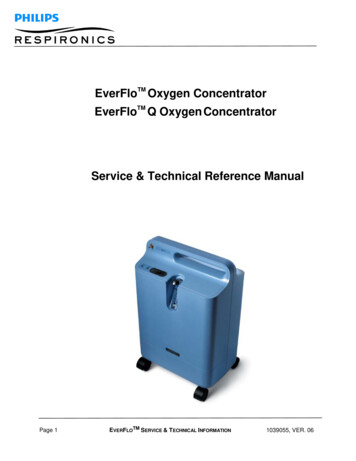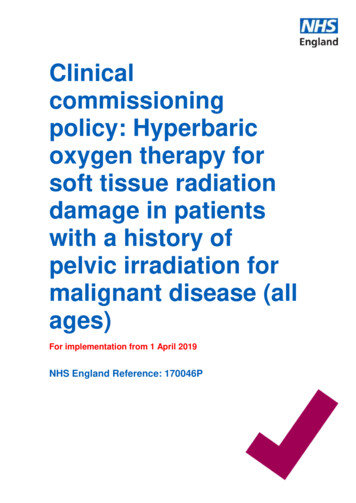
Transcription
Clinicalcommissioningpolicy: Hyperbaricoxygen therapy forsoft tissue radiationdamage in patientswith a history ofpelvic irradiation formalignant disease (allages)For implementation from 1 April 2019NHS England Reference: 170046P
NHS England INFORMATION READER BOXDirectorateMedicalNursingFinanceOperations and InformationTrans. & Corp. Ops.Specialised CommissioningCommissioning StrategyPublications Gateway Reference:07603Document PurposePolicyDocument NameHyperbaric oxygen therapy for soft tissue radiation damage in patientswith a history of pelvic irradiation for malignant disease (all ages)AuthorSpecialised Commissioning TeamPublication Date20 July 2018Target AudienceCCG Clinical Leaders, Care Trust CEs, Foundation Trust CEs , MedicalDirectors, Directors of PH, Directors of Nursing, NHS England RegionalDirectors, NHS England Directors of Commissioning Operations,Directors of Finance, NHS Trust CEsAdditional CirculationList#VALUE!DescriptionNot for routine commissioningCross ReferenceSuperseded Docs(if applicable)Action RequiredTiming / Deadlines(if applicable)Contact Details forfurther information000By 00 January Document StatusThis is a controlled document. Whilst this document may be printed, the electronic version posted onthe intranet is the controlled copy. Any printed copies of this document are not controlled. As acontrolled document, this document should not be saved onto local or network drives but shouldalways be accessed from the intranet.2For implementation from 1 April 2019
Standard Operating Procedure:Clinical Commissioning Policy:Hyperbaric oxygen therapy for soft tissuedamage in patients with a history of pelvicirradiation for malignant disease (all ages)First published: July 2018Prepared by NHS England Specialised Services Clinical Reference Group forHyperbaric oxygen therapyPublished by NHS England, in electronic format only.3For implementation from 1 April 2019
ContentsPolicy statement . 5Equality statement . 5Plain language summary . 51Introduction . 72Definitions . 93Aims and objectives . 104Epidemiology and needs assessment . 105Evidence base. 106Documents which have informed this policy . 147Date of review . 14References . 154For implementation from 1 April 2019
Policy statementNHS England will not routinely commission hyperbaric oxygen therapy for malignantotitis externa (all ages) in accordance with the criteria outlined in this document.In creating this policy NHS England has reviewed this clinical condition and theoptions for its treatment. It has considered the place of this treatment in currentclinical practice, whether scientific research has shown the treatment to be of benefitto patients, (including how any benefit is balanced against possible risks) andwhether its use represents the best use of NHS resources.This policy document outlines the arrangements for funding of this treatment for thepopulation in England.Equality statementPromoting equality and addressing health inequalities are at the heart of NHSEngland’s values. Throughout the development of the policies and processes cited inthis document, we have: given due regard to the need to eliminate discrimination, harassment andvictimisation, to advance equality of opportunity, and to foster good relationsbetween people who share a relevant protected characteristic (as cited underthe Equality Act 2010) and those who do not share it; and given regard to the need to reduce inequalities between patients in access to,and outcomes from healthcare services and to ensure services are providedin an integrated way where this might reduce health inequalities.Plain language summaryAbout soft tissue radiation damage in patients with a history of pelvicirradiation for malignant diseaseRadiation therapy to treat pelvic cancer can damage normal tissue. This willnormally heal on its own following completion of the radiotherapy treatment. In some5For implementation from 1 April 2019
cases, however, serious radiation-related complications can develop months oryears later (Bennett et al 2016). Late tissue radiation damage can significantlyreduce quality of life and can be life threatening (Bennett et al 2016).Areas that are particularly sensitive to soft tissue radiation damage are the pelvis,especially the rectum (Hoggan & Cameron 2014).About current treatmentsTreating tissue radiation damage can include symptom management and surgery toremove or repair the affected area (Bennett et al 2016).Management strategies for patients whose condition fails to respond to standardinterventions remain unclear and lacking in good quality evidence (NHS England2017).About the new treatmentIn hyperbaric oxygen therapy (HBOT) patients receive 100% oxygen inside apressurised treatment chamber (Hoggan & Cameron 2014). The aim of HBOT is toincrease the number of blood vessels in irradiated tissue, improve tissue quality,promote healing and prevent breakdown of irradiated areas (Bennett et al 2016).What we have decidedNHS England has carefully reviewed the evidence to support the addition ofhyperbaric oxygen to the standard treatments for soft tissue radiation damage inpatients with a history of pelvic irradiation for malignant disease.We have concluded that there is not enough evidence to consider making thetreatment available at this time.6For implementation from 1 April 2019
1 IntroductionAbout soft tissue radiation damage in patients with a history of pelvicirradiation for malignant diseaseRadiation therapy to treat pelvic cancers can damage normal tissue in the radiatedarea. This normally heals spontaneously following completion of the radiotherapytreatment. However, in some cases serious radiation-related complications candevelop months or years later (Bennett et al 2016). This can result in fibrosis,ulceration or areas of cell death (radiation necrosis). Late tissue radiation damagecan significantly reduce quality of life and can be life threatening (Bennett et al2016).Areas that are particularly sensitive to soft tissue radiation damage are the pelvis,especially the rectum, and the skin and mucosa of the head and neck (Hoggan &Cameron 2014).Pelvic radiation disease is defined as “transient or long-term problems ranging frommild to severe, arising in non-cancerous tissues resulting from radiotherapytreatment to a tumour of pelvic origin” (van de Wetering et al 2016).Radiation proctopathy is the most commonly investigated late-radiation effect to thepelvis with common symptoms including rectal urgency, rectal incontinence, pain,strictures, mucus discharge and rectal bleeding (van de Wetering et al 2016).Symptoms associated with pelvic radiation can also include bloating, flatulence anddiarrhoea (Glover et al 2016). The pathophysiology and symptomatology of radiationproctopathy are complex because different anorectal sub-regions can be involved(van de Wetering et al 2016).Haemorrhagic cystitis is a diffuse inflammatory condition of the bladder due to aninfectious or non-infectious aetiology resulting in bleeding from the bladder mucosaand is a relatively common and potentially severe complication of high-dose chemoradiotherapy for the treatment of pelvic malignancies (Shao et al 2011). The clinical7For implementation from 1 April 2019
manifestation of this condition can vary from microscopic haematuria to severehaemorrhage with clot formation and urinary tract obstruction. This can lead tohydronephrosis and acute renal failure when it becomes chronic and recurrent (Shaoet al 2011). Symptoms can include urinary frequency, urgency and pelvic pain (Shaoet al 2011).Current treatmentTreatments for late tissue radiation damage include symptom management andsurgery to remove or repair the affected area (Bennett et al 2016). Surgicalintervention in an area that has received radiation therapy is associated with anincreased incidence of delayed healing, infection or breakdown of the surgical wound(Bennett et al 2016).Non-surgical options include aminosalicylic acid derivatives (such as sulfasalazineand mesalazine), short chain fatty acid preparations, sucralfate preparations,coagulation therapy, corticosteroids, formalin applications, pentoxyfilline, antibiotictreatment, hyperbaric oxygen therapy, retinol palmitate and Chinese traditionalmedicine in combination with Western medicine (van de Wetering et al 2016).Management strategies for patients whose condition fails to respond to standardinterventions remain unclear and lacking in good quality evidence (NHS England2017).Proposed interventionIn HBOT patients receive 100% oxygen inside a pressurised treatment chamber(Hoggan & Cameron 2014). Treatments typically involve pressurisation of between2.0 and 2.5 atmosphere absolute (ATA) (203 to 253 kilopascal (kPa)1) for between60 and 120 minutes once or twice daily for a total of 30 to 60 sessions (Bennett et al2016).The aim of HBOT is to increase the number of blood vessels in irradiated tissue,improve tissue quality, promote healing and prevent breakdown of irradiated areas(Bennett et al 2016).11 ATA 101.3 kPa8For implementation from 1 April 2019
2 DefinitionsAminosalicylic acid: is a derivative of salicylic acid which is an active ingredient ofaspirin.Atmospheres absolute (ATA): a measurement used to describe atmosphericpressure; one ATA is roughly equivalent to sea level atmospheric pressure.Coriticosteroids: anti-inflammatory medicines used to treat a range of conditions.Fibrosis: the formation of excess fibrous connective tissue in an organ or tissue in areparative or reactive process.Hydronephrosis: a condition where one or both kidneys become stretched andswollen as the result of a build-up of urine inside them.Pentoxyfilline: a drug that makes blood cells more flexible and less likely to stick tovessel walls – it is used to treat muscle pain in people with artery disease.Radiation therapy/Radiotherapy: a treatment where radiation is used to kill cancercells. There are many different ways you can have radiotherapy, but they all work ina similar way. They damage cancer cells and stop them from growing or spreading inthe body.Retinol palmitate: a form of Vitamin A.Ulceration: the formation of a break on the skin or on the surface of an organ.Radiation proctopathy: a common complication following radiation therapy of pelvicmalignancies. Symptoms include haematochezia (blood in stool), urgency,constipation, diarrhoea and rectal pain.9For implementation from 1 April 2019
3 Aims and objectivesThis policy aims to consider the evidence underpinning the use of HBOT for softtissue radiation damage in patients with a history of pelvic irradiation for malignantdisease.The objectives are to consider whether, in the management of soft tissue radiationdamage in patients with a history of pelvic irradiation for malignant disease: the evidence base supports HOBT as a routine adjuvant treatment the evidence base identifies the place of HBOT in the care pathway there is evidence that the effect of HBOT varies in the following groupso those in whom there is no evidence of recurrenceo those in whom HBOT is used to gain palliative control of symptomso those who receive 30 or more HBOT treatments there is evidence that any beneficial effects are maintained in the medium or longterm there is evidence that HBOT is cost effective when used in this way.4 Epidemiology and needs assessmentLate radiation tissue injury affects between 5% and 15% of long time survivors whoreceived radiotherapy with the incidence varying with dose, age and treatment site(Bennett et al 2016). In patients who have received radiotherapy for pelvic cancer,up to a third subsequently develop chronic moderate or severe gastrointestinalsymptoms (Glover et al 2016).No accurate data were identified to enable an estimation of the proportion of patientsthat have symptoms that are not relieved or rendered manageable by standardinterventions.5 Evidence baseSummary of evidenceNHS England commissioned a review of the published evidence on the use of HBOTtreatment for soft tissue radiation damage in patients with a history of pelvic10For implementation from 1 April 2019
irradiation for malignant disease. To aid in the search for clinically relevant literature,experts in the field of HBOT guided the development of a Population, Intervention,Comparison, Outcome (PICO) framework. Key findings were: The evidence review found two randomised controlled trials (RCTs) comparingHBOT to sham treatment, one randomised controlled trial comparing HBOT tointravesical hyaluronic acid instillation (HA) and one non-randomised controlledstudy comparing HBOT to argon plasma coagulation (APC). The studies considered different outcomes and reported outcomes at differenttime periods following treatment. Outcomes were those most commonly relatedto changes in the symptoms experienced by patients. The most recent trial with 84 patients considered outcomes of gastrointestinalsymptoms, rectal bleeding and bowel dysfunction. This study did not find anysignificant differences in the outcomes for patients receiving HBOT and patientsreceiving sham treatment 12 months after the treatment (Glover et al 2016). The largest trial with 150 patients found a greater improvement in LENT SOMAscore (a scoring system for severity of radiation-induced complications) for theHBOT group than the sham group immediately following treatment (animprovement of 5.00 points for HBOT and 2.61 points for sham) (Clarke et al2008). This study also found that a greater proportion of HBOT patients showed at leastsome improvement on clinical evaluation immediately following treatment (89%vs 63%) (Clarke et al 2008). Four categories were used for clinical improvement:healed, significant improvement, moderate improvement or no improvement. Theproportion of patients that were considered healed in each group was 8% forHBOT and 0% for sham. No definition was provided to explain what was meantby a moderate or significant improvement. Quality of life outcomes were reported in one trial (Clarke et al 2008). This foundno difference between HBOT and sham patients in general well-being assessedimmediately after treatment. The study did find that the HBOT group had agreater improvement from baseline (14%) than the sham group (5%) on a bowelbother scale. However the HBOT group had a lower score at baseline and thebowel bother scores were similar for both groups immediately following treatment(approximately 60%).11For implementation from 1 April 2019
The evidence review also found two small studies that compared HBOT to othertreatments. These were intravesical hyaluronic acid instillation (HA) in patientswith haemorrhagic cystitis (Shao et al 2011) and argon plasma coagulation (APC)in patients with radiation proctopathy (Álvaro-Villegas et al 2011). Shao et al (2011) found no significant difference between HBOT and HA in theproportion of patients showing a partial or complete response to treatment (75%in both groups at final follow-up 18 months after treatment). No direct comparison of the two groups was done for the other outcomesreported by Shao et al (2011) of voiding (urinating) frequency and pelvic pain. Animprovement from baseline was seen in both groups for voiding frequency at sixmonths (by approximately one to three voids per day from a baseline ofapproximately 10 voids per day). However this improvement was not sustainedover the 18 month follow-up period. An improvement in pelvic pain from baselinewas seen in both groups at six, 12 and 18 months. This improvement wasapproximately one point on a 10-point pain scale from a baseline ofapproximately two to three points. Álvaro-Villegas et al (2011) found no significant difference between HBOT andAPC for change in haemoglobin level at one, two or three months follow-up. Forthe other two outcomes assessed (number of transfusions and tissue toxicity) theimprovement was greater in the APC group in the first two months. By threemonths the HBOT group had also improved and there was no significantdifference between the groups. In both groups the number of transfusionsrequired ranged from approximately four to five at baseline to less than one atthree months follow-up. The time period over which transfusions were receivedwas not specified. One study reported a significantly higher incidence of urinary tract infection (UTI)in the HA group (43%) compared to the HBOT group (10%) at six months followup (Shao et al 2011). There was no significant difference between the groups atlater follow-up with a UTI incidence of 50% for the HA group and 30% for theHBOT group at 18 months follow-up. Other studies did not report any analysis comparing the number of adverseevents between HBOT and sham or other treatments.12For implementation from 1 April 2019
Common adverse events in patients receiving HBOT were eye changes includingmyopia (30% in one study) and ear pain (28% in one study). No studies assessing the cost effectiveness of HBOT for soft tissue radiationdamage were identified. There were limitations in the studies reported. The two trials comparing HBOT tosham did not include all patients in their analysis, reducing confidence in theirresults, and the study authors did not always include enough information toenable the reader to understand the importance of their results. Direct comparison between the studies is not possible due to the differentcomparators used, the different outcome measures reported and the differenttime periods used for the assessment of outcomes following treatment. At present there is inconsistent evidence about the efficacy of HBOT compared tosham in the treatment of soft tissue radiation damage following pelvic irradiation.Further adequately powered trials comparing HBOT to sham may be warranted.ConclusionThe evidence identified for HBOT for the treatment of soft tissue radiation damageafter pelvic irradiation included three randomised controlled trials and one nonrandomised controlled study.Studies reported improvements from baseline following HBOT treatment. However,only one of the two studies comparing HBOT to sham provides evidence of betteroutcomes with HBOT treatment. This was the largest study identified, but onlyreported comparative outcomes immediately following treatment and the clinicalmeaningfulness of the improvements observed with HBOT is unclear.Two small studies comparing HBOT to other treatments also showed improvementwith HBOT but HBOT was not superior to the alternative treatments.At present there is inconsistent evidence about the efficacy of HBOT compared tosham in the treatment of soft tissue radiation damage following pelvic irradiation.HBOT was not superior to alternative treatments in two small studies. Given thediscrepancy in the results of the two sham-controlled trials identified and the13For implementation from 1 April 2019
limitations of these studies, further adequately powered trials comparing HBOT tosham may be warranted.6 Documents which have informed this policyThis document replaces the present NHS England Clinical Commissioning Policy(2013): Hyperbaric Oxygen Therapy . df7 Date of reviewThis document will be reviewed when information is received which indicates that thepolicy requires revision.14For implementation from 1 April 2019
ReferencesÁlvaro-Villegas JC. Sobrino-Cossio S. Tenorio-Téllez LC. de la Mora-Levy JG.Hernández-Guerrero A. Alonso-Lárraga JO. Vela-Chávez T. 2011. Argon plasmacoagulation and hyperbaric oxygen therapy in chronic radiation proctopathy,effectiveness and impact on tissue toxicity. Rev. Esp. Enferm. Dig (Madrid) 103(11):576-581.Bennett MH. Feldmeier J. Hampson NB. Smee R. Milross C. 2016. Hyperbaricoxygen therapy for late radiation tissue injury. Cochrane Database of SystematicReviews Issue 4 Art. No.: CD005005.Clarke RE. Tenorio LMC. Hussey JR. Toklu AS. Cone DL. Hinojosa JG. Desai SP.Parra LD. Rodrigues SD. Long RJ. Walker MB. 2008. Hyperbaric oxygen treatmentof chronic refractory radiation proctitis: a randomized and controlled double blindcrossover trial with long-term follow-up. International Journal of Radiation Oncology,Biology, Physics 72(1): 134-143.Glover M. Smerdon GR. Andryev HJ. Benton BE. Bothma P. Firth O. Gothard L.Harrison J. Ignatescu M. Laden G. Martin S. Maynard L. McCann D. Penny CEL.Philips S. Sharp G. Yarnold J. 2016. Hyperbaric oxygen for patients with chronicbowel dysfunction after pelvic radiotherapy (HOT2): a randomised, double-blind,sham-controlled phase 3 trial. Lancet Oncology, 17: 224-33.Hoggan BL. Cameron AL. 2014. Systematic review of hyperbaric oxygen therapy forthe treatment of non-neurological soft tissue radiation-related injuries. Support CareCancer 22: 1715-1726.NHS England. Population, Intervention, Comparator and Outcomes (PICO).Hyperbaric oxygen therapy for soft tissue radiation damage. March 201715For implementation from 1 April 2019
Shao Y. Lu GL. Shen ZJ. 2011. Comparison of intavesical hyaluronic acid installationand hyperbaric oxygen in the treatment of radiation-induced hemorrhagic cystitis.BJU International 109: 691-694.van de Wetering FT. Verleye L, Andreyev HJN. Maher J. Vlayen J. Pieters BR. vanTienhoven G. Scholten RJPM. 2016. Non-surgical interventions for late rectalproblems (proctopathy) of radiotherapy in people who have received radiotherapy tothe pelvis. Cochrane Database of Systematic Reviews Issue 4 Art No.: CD00345516For implementation from 1 April 2019
Hyperbaric oxygen therapy for soft tissue radiation damage in patients with a history of pelvic irradiation for malignant disease (all ages) Superseded Docs (if applicable) Contact Details for further information Document Status 0 This is a controlled document. Whilst this document may be printed, the electronic version posted on
